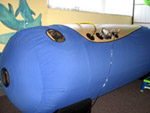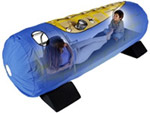|
Home
Stroke, Traumatic Brain Injury, and
Hyperbaric Oxygen Therapy
Testimonial
Article written and Shared by
Dr. Geoffrey H. Saft, D.C.
//hyperbaric-oxygen-ca.com
My husband suffered strokes in August 2006 that
resulted in total loss of short-term memory, slurred speech, and
difficulty walking. The doctors said he may never recover, and if he
did it would take at least two years. Now, after only two months of
hyperbaric therapy his memory is back, and his speech and walking
are normal. His energy has improved. Dr. Saft is one of the most
caring individuals we have ever met. We can't thank him enough for
what he has done for us. Marge H.
Conditions that harm the brain have a wide reach.
Whether from a stroke (vascular accident) or a traumatic brain
injury, the results impair the whole family.
The loss, or potential loss, of hopes, dreams, and expected joys and
accomplishments is a loss suffered by all of those who care.
Brain damage has a wide reach; it damages the whole
family.
Hyperbaric Oxygen Therapy is not a cure . . . . but
it can often help.
Following is a MUST SEE video from the
Montel Williams Show.
Even though science now knows better, the
“old-school” idea still often remains: that once an area of the
brain has been damaged by a stroke, TBI (traumatic brain injury), or
near drowning, that nothing or very little can be done to restore
the function of that area.
Recent scientific research has demonstrated that
while the core-area of the damaged brain tissue may be irreversibly
damaged, there is an area surrounding this tissue that hyperbaric
oxygen therapy can restore and these neurons (brain/nerve cells) can
re-establish their function.
The majority of tia, stroke and brain injuries are
caused by blood vessel obstructions, such as a blood clot, that cuts
off blood flow and oxygen to parts of the brain. This results in the
death of nerve cells within a very short time. These dying brain
cells begin to swell due to their cell walls breaking down, allowing
fluid to move into the cells. As these cells swell, they begin to
expand into the surrounding tissues. This causes constriction of the
blood vessels in the surrounding tissues, which then causes a lack
of oxygen to these previously normal cells. These surrounding cells
then begin to swell as well. This gradually increasing, damaged,
hypoxic tissue surrounding the original injury is called the
"ischemic penumbra," and contributes up to 85% of the disability
resulting from a stroke. The cells in this secondary area have the
potential of being restored to near-normal, and sometimes normal
function.
The neuroscientist Dr. Cyril B. Courville wrote,
"crippled nerve cells may persist in the margins of wounds of the
brain for many years." Astrup, Siesjo and Symon suggested that
within these damaged margins, idling neurons are present. They are
metabolically lethargic and are non-functional, because of low
oxygen levels and secondary damage. But they remain viable and are
subject to being revived with hyperbaric oxygen therapy.
Proof of this dormant life of the brain’s cells has
been demonstrated with the use of SPECT brain scans done before and
after a series of hyperbaric oxygen therapy. In the journal Stroke,
Dr. Richard Neubauer, a pioneer in the use of this therapy for
treating various neurological diseases, reported outstanding results
in a group of 122 stoke patients treated with HBOT. In one case,
significant functional improvement was noted when Hyperbaric Oxygen
Therapy was used 14 years after the initial stroke.
These studies by Dr. Richard Neubauer conclusively
demonstrate the development of new blood vessels to the rim of
tissue surrounding the area of the brain that had been damaged.
These newly formed blood vessels resulting from the
hyperbaric oxygen therapy can then bring fresh blood (oxygen) and
nutrients to the damaged tissue. The tissue begins to repair itself
and returns to normal or near-normal. These "resuscitated" neurons
gradually reconnect to the rest of the brain. These revived neurons
and their connections help to return the use of lost cerebral and
bodily functions.
Hyperbaric therapy does not resurrect dead brain
tissue, but it can facilitate the functioning of those dormant,
idling nerve cells that have suffered secondary damage by stroke due
to diminished oxygen. Oftentimes, the brain area suffering secondary
damage is a larger part of the brain than that which suffered the
primary damage. This area of secondary damage to the brain (the
ischemic penumbra) is the area that HBOT helps.
Improvements have been achieved, gains have been
made, even with patients who are more than a decade post-stroke.
Note: TIA: Transient Ischemic Attack, is a "mini
stroke", or "warning stroke" that often produces mild stroke-like
symptoms but usually no lasting damage. A TIA is often a forecast of
a full-fledged stroke on the horizon, which makes this a good
indicator for beginning this therapy.
Day after day, patients are overcoming the bleak
forecasts about recovery from their stroke or traumatic brain
injury, using Hyperbaric Oxygen Therapy
Chambers
To Choose From
Click on
the Picture to Go To the Detailed Page
Free Shipping on all chambers w/in the USA
PORTABLE HYPERBARIC OXYGEN CHAMBERS

Equipment Financing Partner of Balanced Health Today
Single Bag Chamber

Find out more
Our Single Bag Chamber sells for $12,900. It is 36 inches in diameter and 108
$12,900

|
|
Double bag Chamber

Find out more
Our Double Bag Chamber sells for $16,900. It is 34 inches in diameter and 105
$16,900

|
|
Balanced Health Today
355 Hukililke Street ( suite 206)
Kahului, Hi 96732
//www.BalancedHealthToday.com
info@BalancedHealthToday.com
888.449.0552 |